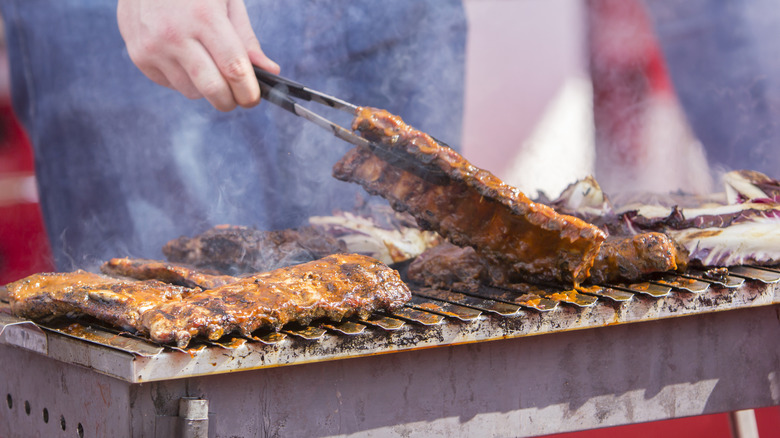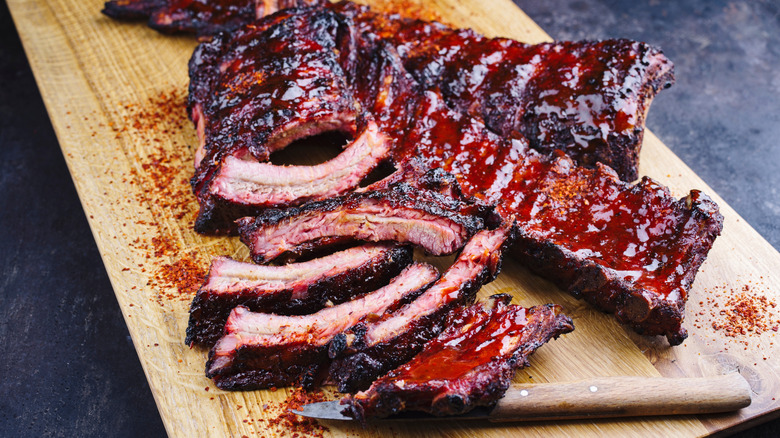What's The Difference Between Baby Back Ribs And Spareribs?
I LOVE barbecue ribs. I look forward to the 4th of July not because I want to display my patriotism, but because I cannot wait to get an invite to everyone's home since I know they're going to throw some ribs on the grill. To be honest, I could eat them at least 4 times a week without flavor fatigue. That's all to say, as much as I love them, I couldn't tell you the difference between baby back and spareribs to save my life.
For anyone else who's in the dark, here's a brief rundown. Both cuts come from the pig, but their placement, size, and texture make them suited to different cooking methods and flavor profiles. Baby back ribs, or loin ribs, come from the upper rib cage, closer to the spine. They're shorter, curved, and leaner compared to spareribs. These ribs are for the people who want tender meat with less fat. Spareribs come from the lower ribcage, near the belly. They're larger, flatter, and have more fat marbling, which gives them a rich, mouthwatering flavor.
Baby backs are quicker to cook and perfect for grilling, while spareribs benefit from longer cooking methods like smoking or braising to achieve their supreme tenderness. That's Barbecue 101 for the rookies like me who just want to sit down and get to it. If you're the person grilling, you definitely need to know the difference. Here's a deeper dive into what makes each cut unique and delicious.
Choosing between baby back and spareribs
Baby back ribs are the top choice for lean, tender meat that's easy to handle. Their lower fat content gives them a cleaner, lighter flavor, which appeals to those looking for a less fatty option. What makes baby back ribs particularly appealing is their versatility. They cook faster than spareribs, typically taking 1.5-2 hours on a grill or in the oven. A simple dry rub can enhance their flavor, and smothering them in a signature homemade barbecue sauce adds the perfect finishing touch.
Beyond traditional barbecue, baby back ribs work well with a variety of cuisines. You can experiment with Asian-inspired marinades, spicy jerk seasonings, or even citrus-based glazes for a fresh twist. Their smaller size also makes them perfect for appetizers (try this copycat Chili's baby back ribs recipe) or small plates. You can serve them at a party or as part of a weeknight dinner, and either way, baby back ribs deliver a reliable, delicious result every time.
If you're after bold, rich flavors, spareribs are the perfect choice. The fat slowly renders as the ribs cook, infusing the meat with a deep, juicy flavor that is otherworldly. While they're tougher than baby back ribs, the right cooking methods can turn them into a tender delight. I also found out that this cut yields one of my absolute favorites: Rib tips. This version features the small, flavorful sections of meat and cartilage that are trimmed off when spareribs are cut down to St. Louis-style ribs. Baby back ribs, on the other hand, don't have rib tips.
Spareribs thrive with low-and-slow cooking, and you can even throw them in the instant pot. They often take 3-4 hours to reach their signature fall-off-the-bone texture. These hearty ribs are also great for exploring international flavors. Use a Korean marinade for kalbi-inspired ribs or a Cajun rub for a spicy aftertaste. Adding a dry rub, mop sauce, or tangy barbecue glaze enhances their taste and keeps them moist.

